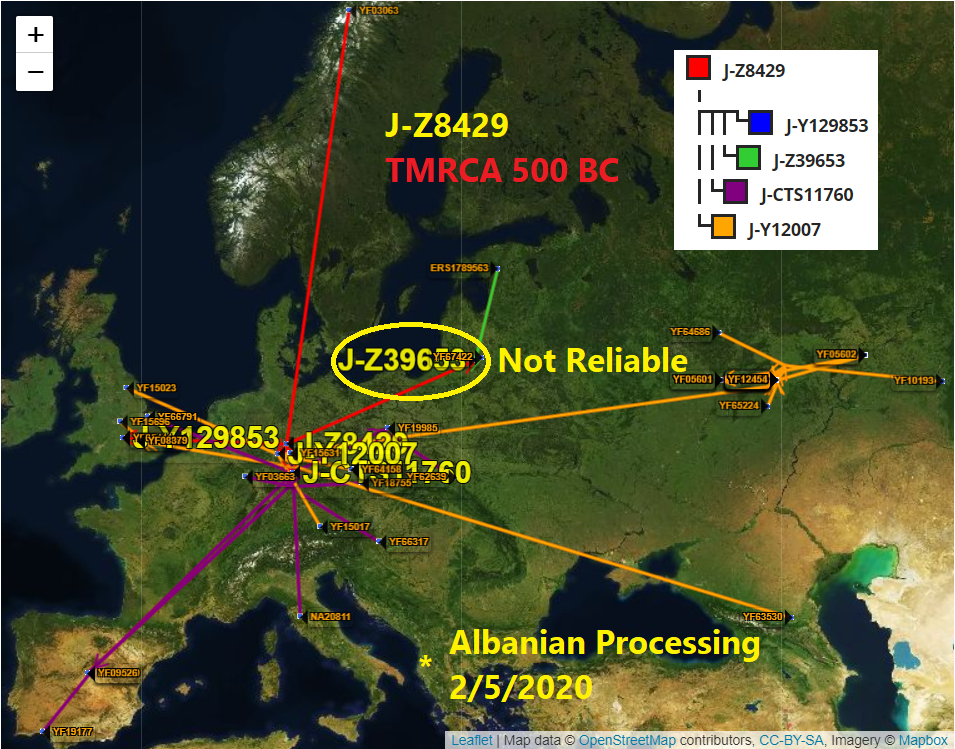Background: Religion doesn't come from DNA - It comes from parents
A religion is not tied to the molecules in our DNA - but in many religions, the parents dictate the religion of their children. In this sense, a genetic lineage's association to a particular tradition should be seen as a "nurture" rather than a natural cause.
While according to the traditional rules of Judaism, the mother is compelled to raise her children Jewish, there are many instances of male lineages which have for dozens of generations sired offspring who continued the Jewish tradition.
This is likely because most Jewish men in the Middle Ages mated more with Jewish women and their children were then raised in the tradition of their mothers - whether or not they were married.
J-Z39653 - A Jewish Lineage of J-L283
J-Z39653 is a male lineage in the European branch of J-M241 called J-L283>Z622.
The group J-Z39653 descend from a common ancestor who lived around 870 AD and today almost exclusively all have a history of the Jewish tradition.
This article will focus on determining where their ancestor may have been living before 870 AD, which can help inform theories on where/when the lineage acquired the Jewish tradition.
To learn about how their (and all European J-L283's) more distant ancestor, J-Z622, may have migrated to Europe 5400 - 5700 years ago - J-L283’s Armenian Connection
I recently found by looking at the FTDNA Haplotree that there is a group of men of unknown origin who are J-Z39653's next closest relatives. Prior to this discovery, the next closest relatives of these men were J-Z8429 - though very distant relatives at 500 BC. This is an extremely geographically diverse lineage as you can see below.

The origin of J-Z8429 (lineages depicted above) is not conclusively known but Central Germany is a possibility. Note that there is an Italian in CTS11760, that an Albanian is currently processing and that so far the only ancient J-Z631 (distant cousin) found has been in an ancient Roman necropolis (though this man had some "Western" autosomal DNA).
The origin of J-Z39653 as depicted above in the Baltic region is not reliable given the small number of samples and lack of samples descending from a common ancestor who lived before several significant Jewish expulsions. There is also no historical record of Jews living in the Baltic region by that time.
For more detailed information about Jewish expulsions, I've distilled some notes from a knowledgeable researcher Ted Kandell from Open Genomes - https://phylogeographer.com/g-y12975/
Given the context of Z8429, Z1043 and Z631 distribution that does include Southern Europe with an ancient sample and the fact that other Jewish lineages have been traced to origins in Southern Europe, this may be a more likely origin for J-Z39653 absent other data.
An origin in the Levant for J-Z39653 seems unlikely given that there is no diversity in the Levant for parent J-Z8429 or it's successive parents. Instead, the diversity appears between Central Europe and Southern Europe. If the origin were the Levant then two migrations need to have happened - a migration from Europe to the Levant for J-Z39643 and then back to Europe - a less simple explanation but still possible.
The Discovery of J-Z39655 Can Help Solve the Mystery of J-Z39653's Origins
Two men have tested Big Y and share two mutations in common with the men in J-Z39653 but are negative for the rest.
This means that their common ancestor with J-Z39653 may have lived 300-500 BC. If we can identify who these men are:
- YFull analysis would result in a more reliable estimate of when their common ancestor with J-Z39653 lived
- Where they trace descent will inform our theory of where J-Z39653's ancestors were living
Based on the number of mutations it looks like the common ancestor would have been living in Europe before Judaism was known to exist there. However if these two distant relatives of J-Z39653 are also Jewish it would point to the possibility that their common ancestor also was Jewish.
Unfortunately these men have not listed a country of origin, appear not to have joined a public project and are outside the cutoff used by FTDNA to permit Big Y relatives to communicate.
So even though these men are the closest relatives of the Jewish J-Z39653 it is impossible to contact them to advance research into their common origins. If FTDNA changed one line of code they would be able to facilitate this discovery rather than offer us a tantalizing glimpse.
Anyone who is J-Z39653 and wants to help in the effort to identify these men.
- Search your 12, 25 or 37 marker matches for any man with "J-Z39655" listed as haplogroup
- Direct them to this article
- Encourage them to join the J-M241 Haplogroup Research Project
- Tell FTDNA you are unhappy with the fact that volunteer researchers need to work extra hard to make meaningful discoveries such as this that FTDNA could automatically facilitate by flipping a switch.
